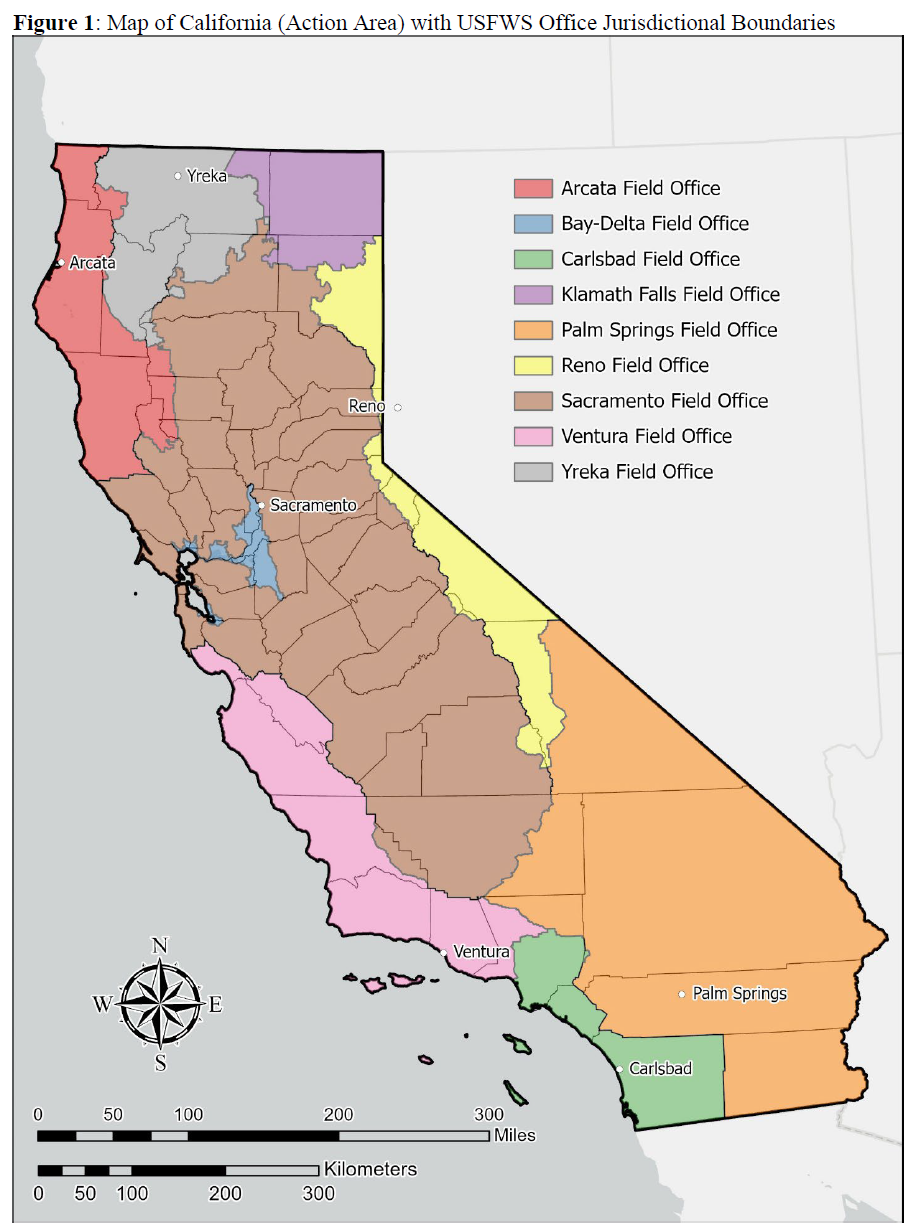The U.S. Fish and Wildlife Service (USFWS) is dedicated to the conservation, protection, and enhancement of fish, wildlife and plants, and their habitats. The primary way that USFWS intersects with restoration project permitting is through its responsibility to implement the federal Endangered Species Act (ESA).
Permit triggers
Designated critical habitat or the presence of federally protected plant or animal species triggers ESA compliance needs and is often revealed in a biological survey as part of CEQA compliance. When species are found, coordinate with USFWS or National Marine Fisheries Service (NMFS, for anadromous fish/salmonids) as soon as possible to design your project to minimize impacts on the species.
You can begin searching for possible species habitat/presence by using the USFWS’ Information for Planning and Consultation (IPaC) website to define the project area and receive an official species list. The Official Species List is required for any federal project. Most aquatic or riparian restoration projects that require consultation with USFWS will go through the Section 7 consultation process.
Section 7 Consultation
Federal agencies consult with the U.S. Fish and Wildlife Service (Service) to avoid jeopardizing the existence of listed species and/or their critical habitat, which would violate the Endangered Species Act (ESA). These consultations are conducted under Section 7 of the ESA.
Non-federal parties, including individuals, cannot consult directly under section 7. However, there are many ways to make a “federal nexus” between a non-federal project and a federal agency. This allows non-federal parties to consult indirectly through that agency.
A “federal nexus” usually comes in the form of requesting another federal permit (often a 404 permit from the Army Corps), or funding from a federal agency (e.g., USFWS Partners Program, NOAA Restoration Center) for a project that could affect listed species. The appropriate federal agency will consult with the appropriate USFWS Field Office (FWO) about your project. The type of consultation will be either informal or formal (see below) depending on whether your project affects listed or protected species.
In simple terms, you cannot get your federal permits (e.g., Army Corps 404 permit) or funding from a federal agency (e.g. USFWS, NOAA, NRCS) until that agency has complied with Section 7 of the ESA and received authorization from either USFWS or NMFS to move forward, so you must work with those agencies to help them comply.
Programmatic Biological Opinions
When possible, try to use an existing programmatic Biological Opinion, such as the USFWS Statewide Restoration Programmatic Biological Opinion (PBO) or other PBOs listed on the right side of this page, for formal Section 7 consultation instead of having to write an individual project biological assessment and receive a biological opinion from the USFWS. Below is the map of the Action Area for the Statewide Restoration (PBO) and USFWS Office jurisdictional boundaries.

Informal vs. Formal Consultation
If the agency believes that the project may affect the species, but not adversely, it asks for an informal consultation. In an informal consultation, the action agency asks the FWO to concur that their project is not likely to adversely affect the species.
If a federal agency believes that a project may adversely affect a listed species, it requests a formal consultation. In a formal consultation, the action agency asks the FWO to concur that their project will not jeopardize the species. After completing a formal consultation, the FWO writes a biological opinion. Biological opinions state the Service’s opinion regarding whether or not a federal action is likely to jeopardize the continued existence of listed species or result in the destruction or adverse modification of critical habitat.
See the ESA Section 7 Consultation Handbook for more information.
Habitat Conservation Plans
If you have a project that may adversely affect listed species, but no federal agency is involved in the process, you may need to develop a Habitat Conservation Plan, under Section 10 of the Endangered Species Act. This is generally a longer, more comprehensive process.
USFWS Partners for Fish and Wildlife Program
The Partners for Fish and Wildlife Program is a voluntary program that provides free technical and financial assistance to private landowners interested in improving wildlife habitat on their lands. Projects are voluntary and collaborative to meet landowners’ needs. Participating landowners continue to own and manage their land while they improve conditions on their lands for wildlife.
USFWS staff provide free technical and financial assistance to plan, design, and supervise wildlife habitat restoration projects. Examples of habitats that they work in within this region include wetlands, streams, riparian, grasslands, and mountain meadows. Projects can range in size from a few to hundreds of acres and a few hundred feet to miles of riparian and/or stream.
If interested, contact the California State Coordinator or your local Partners Program biologist. They can provide informal advice on wildlife-friendly practices and discuss your project ideas. If the Partners Program fits your needs, they will walk you through the process to receive financial assistance.
California
Matt Hamman
11641 Blocker Drive, Suite 110
Auburn, CA 95603
530-889-2301
matt_hamman@fws.gov
Mike Edwards – Klamath Basin Coordinator
1936 California Avenue
Klamath Falls, OR 97601
541-885-2505
mike_edwards@fws.gov
Nevada
Susan Abele
1340 Financial Boulevard
Suite 234
Reno, NV 89502
775-861-6346
Email: susan_abele@fws.gov


Accelerated Permitting Pathways
- USFWS Statewide Restoration Programmatic Biological Opinion (PBO)
- USFWS PBO for Projects that May Affect the California Red-legged Frog (Ventura FWO)
- East Alameda Conservation Strategy Programmatic BO
- Alameda County Conservation Partnership Permit Coordination Program
- Santa Cruz County Partners in Restoration Permit Coordination Program (PIR)
